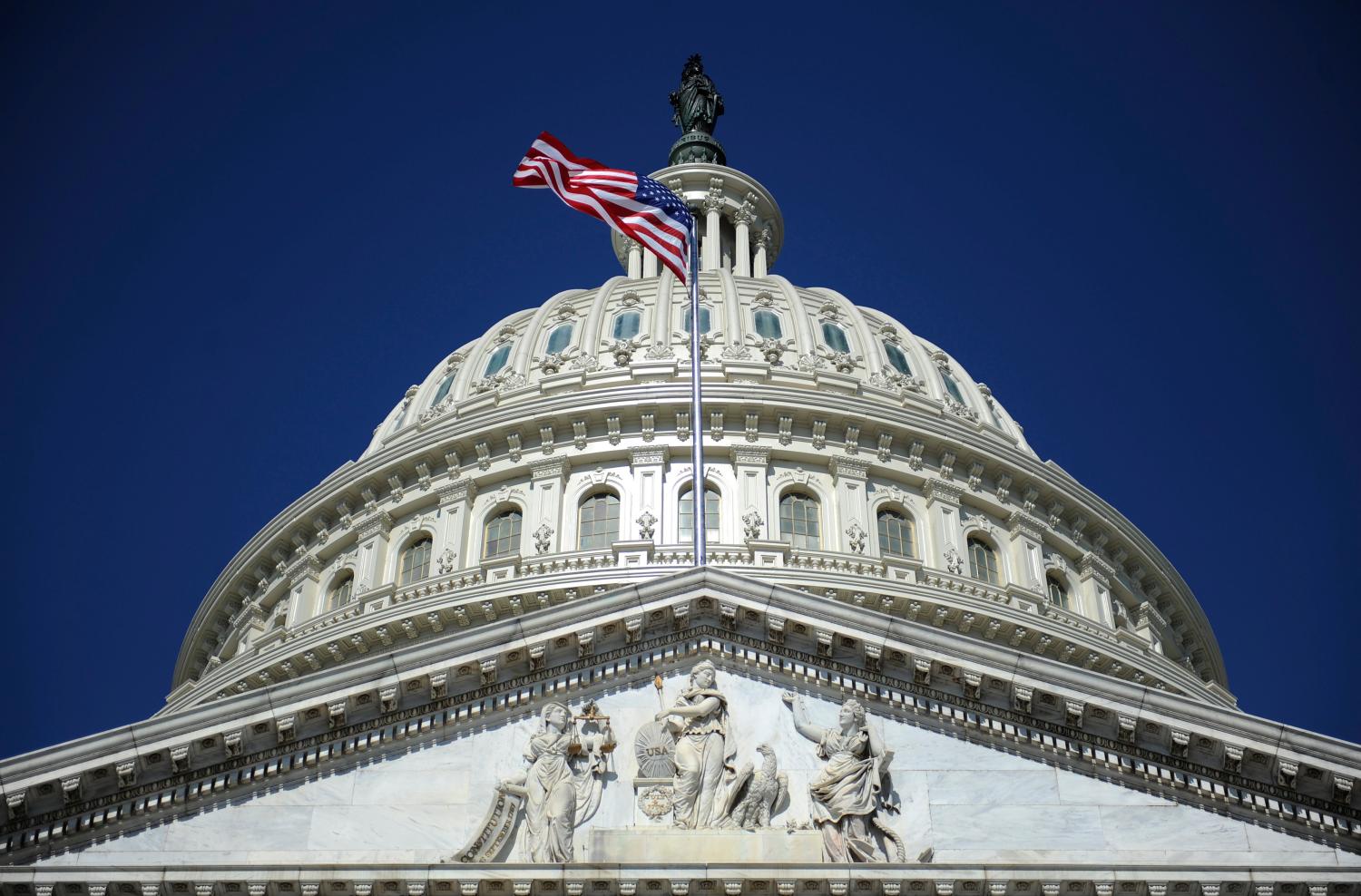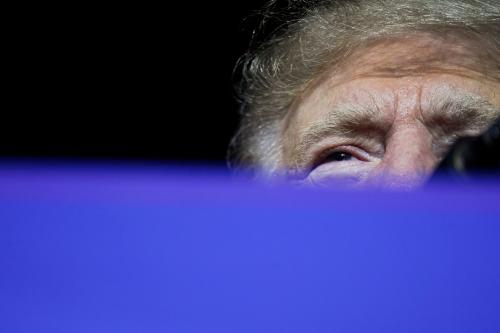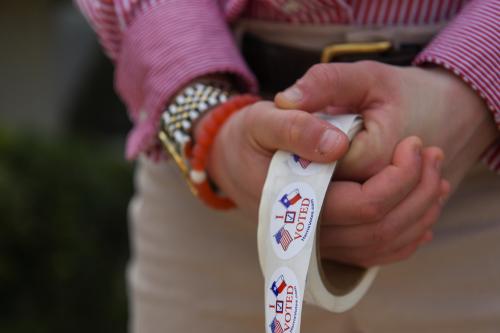Party primaries are now the most consequential elections in American politics. For many years they have been the ugly stepchild of American politics; ignored by journalists and snubbed by political scientists. All that is changing as the trend towards more and more safe seats appears to be continuing. With more and more states and congressional districts becoming dominated by one party or the other, the most consequential choices for voters come in party primaries. At the Brookings Primary Project, we are studying all the candidates in congressional primaries. This is the second piece in Brookings’ Primaries Project. The first one dealt with the Texas Primaries in March. Special thanks to Andy Cerda, Jordan Muchnick, Sylvia Garrett and John Hudak for their work on the 2022 Primaries Project.
Conventional wisdom paints former president Donald Trump as the undisputed leader of the Republican Party. Is this true or is it a case of media exaggeration? Let’s have a careful look at the two large states that held their primaries on May 3—Indiana and Ohio.
The most watched race in the May 3 primaries was the Republican primary for the Senate seat being vacated by Sen. Rob Portman who is retiring. In that seat J.D. Vance, author of the famous book Hillbilly Elegy, was endorsed by Trump even though Vance had previously called Trump “reprehensible” and an “idiot” and admitted to not voting for him in 2016. Trump’s endorsement turned out to be powerful, as it pushed Vance to the front of the pack and caused some resentment among Trump stalwarts. According to Politico, “Nearly three dozen Trump supporters and convention delegates signed an open letter to Trump this week expressing their “feeling of betrayal” over his support for Vance, referring to him as a “Never Trumper” who “has not developed relationships” with the Republican grassroots.” With the exception of state senator Matt Dolan, all the other candidates spent the campaign tripping over themselves trying to prove that they were the most like Trump even though Trump hadn’t endorsed them. In the last poll before election day, the least Trump-like candidate, Dolan made it into the top three—perhaps as a result of voter fatigue over the sniping between Vance and Josh Mandel, the former state treasurer. But in the end, Trump’s candidate prevailed, in much the same way as Trump had prevailed—by winning huge margins in rural counties.
Trump (mostly) plays it safe …
We’ve only had primaries in three states so far. Prior to Indiana and Ohio the Texas primary was March 1. In Texas, Trump’s candidate also won the most high-profile race—the race for Attorney General. But looking at all Trump’s endorsements his achievements are more modest. In Texas, most of Trump’s endorsed candidates were in uncontested races or they were incumbents. Endorsing incumbents is not a good measure of the endorser’s power since historically incumbents win over 90% of their primaries; money, name identification, constituent service all contribute to their electoral advantages. In Texas, Trump endorsed only two challengers—Monica de la Cruz Hernandez and Wesley Hunt and both candidates won.
Trump playing it safe was a strategy on display in Indiana as well. Overall, in the state, Trump endorsed six out of the 28 Republican candidates. All six of them, however, were incumbents and five were in uncontested primaries: Reps. Jackie Walorski (IN-2), Jim Banks (IN-3), Jim Baird (IN-4), Victoria Spartz (IN-5), and Larry Buschon (IN-8). The only Trump endorsed candidate to have a challenger was Greg Pence (IN-6) who easily beat his opponent. Even in the solidly-Republican seat of IN-9, Trump did not endorse a candidate. By contrast, members of Congress like Elise Stefanik, Jim Jordan, and Tom Cotton have all endorsed different candidates in the race. Not surprisingly, none of the Trump candidates (incumbents with no opponents save Pence) lost.
In Ohio there were 44 candidates running in Republican primaries for House and Senate, and Trump endorsed 12. Of these candidates nine were incumbents or running in uncontested seats. The Trump candidates who were challengers were J.D. Vance in the Senate race, Max Miller in OH-7 and Madison Gesiotto Gilbert in OH-13. When the votes were counted all three of the candidates that Trump endorsed who had actual races won. As in Texas, Trump candidates won the races that count, there just weren’t very many of them.
How are the Trump wannabes doing?
A second way of assessing Trump’s strength is by seeing how candidates who wrap themselves in Trump perform in contrast to those who hold Trump at arm’s length. In both states there were plenty of Trump wannabes running. In Indiana, of the 28 Republicans, 11 (39%) were clearly running on the MAGA/Trump playbook while 14 (50%) were running as mainstream conservatives. The Trump wannabes won 36% of their races, while the mainstream conservatives did a little better, winning 43% of their races.
In Ohio, of the 44 Republicans running, 14 (32%) were clearly running on the MAGA/Trump playbook while 22 (50%) were running as mainstream conservatives. There the numbers were reversed. Trump wannabes won 50% of their races, while the mainstream conservatives won 32%.
Indiana congressional and Senate candidates by ideology within party
| Candidate’s Ideology | Number of candidates | Won | Lost |
| MAGA/Trump Conservative | 11/28 (39.2%) | 4/11 (36.36%) | 7/11 (53.64%) |
| Mainstream Conservative | 14/28 (50%) | 6/14 (42.86%) | 8/14 (57.14%) |
| Moderate Conservative | 0 | 0 | 0 |
| No data available | 3 (10.7%) | 0 | 3 (100%) |
Ohio congressional and Senate candidates by Ideology within party
| Candidate’s Ideology | Number of candidates | Won | Lost |
| MAGA/Trump Conservative | 14/44 (31.8%) | 7/14 (50%) | 7/14 (50%) |
| Mainstream Conservative | 22/44 (50%) | 7/22 (31.82%) | 15/22 (68.18%) |
| Moderate Conservative | 4/44 (9%) | ¼ (25%) | ¾ (75%) |
| No data available | 4/44 (9%) | ¼ (25%) | ¾ (75%) |
What about the Democrats?
On May 3, the Democratic side lacked a big national race like the Ohio Republican Senate contest that pitted Trump’s choice, J.D. Vance, against a field of more established Republican candidates. Congressman Tim Ryan (OH-13) easily won the Democratic nomination for the Senate race. The only race with some national significance was the re-match between Rep. Shontel Brown and Nina Turner in OH-11. Turner is a very close ally of Sen. Bernie Sanders and a powerhouse on the left-wing of the Democratic party. She lost to Brown in 2020 and this time she was badly outspent and lost again.
Neither Indiana nor Ohio was very fertile ground for the left-wing of the Democratic party. In Indiana, only five candidates ran as progressives and one as a Democratic Socialist out of 22 Democratic candidates. Only incumbent Rep. Andre Carson (IN-7) won his race. In Ohio, there were seven progressive candidates and one Democratic Socialist running. Only Amy Rippel-Elton (Oh-12) and Shontel Brown won their races. (Brown, a moderate-backed progressive defeated a Bernie Sanders backed candidate.)
Who were the candidates in these primaries?
If the biggest takeaway from the 2018 primaries was the large number of women running, the biggest takeaway from the primaries in these two states is the large number of veterans running. In Indiana, 19 (38%) of the 50 total candidates identified as a veteran. In Ohio, 13 (~18%) of the 73 candidates identified as vets. In total, 32 veterans ran in the May 3 primaries, making up around a quarter (~26%) of all candidates.
In terms of other demographics, the candidates of the May 3 primaries were mostly white, male, married, and college educated.
In Indiana, there were 22 candidates running in the Democratic primary and 28 candidates running in the Republican primary. Most candidates were white (74% of all candidates, 82% of all Republican candidates and 64% of all Democratic candidates), with the second highest number being African American (12% of all candidates, 4% of all Republican candidates and 23% of all Democratic candidates) and the third highest being Latino (4% of all candidates, 7% of all Republican candidates, 0% of Democratic candidates). Most mentioned they were married (60% of all candidates, 68% of all Republicans and 50% of all Democrats). They were also overwhelmingly male, with men making up 82% of all candidates (75% of all Republican candidates and 91% of Democratic candidates) and women making up 18% of all candidates (25% of all Republican candidates and 9% of all Democratic candidates). They were also very college educated, with 76% having at least a four-year college degree and 42% having more than a four-year degree.
In Ohio—there were 29 candidates running in the Democratic primary and 44 candidates running in the Republican primary. Like Indiana, most candidates were white (71% of all candidates, 82% of all Republican candidates and 55% of all Democratic candidates), with the second highest number being African American (16% of all candidates, 9% of all Republican candidates and 28% of all Democratic candidates) and the third highest being Latino, Mixed Race, or ‘Other’ (each 3% of all candidates). They were also overwhelmingly male, with men making up 77% of all candidates (86% of all Republican candidates and 62% of all Democratic candidates) and women making up 22% of all candidates (14% of all Republican candidates and 34% of all Democratic candidates). Unlike Indiana, only a plurality mentioned they were married (44% of all candidates, 52% of all Republicans and 31% of all Democrats). However, they were also very college educated, with 78% having at least a four-year college degree and 47% having more than a four-year degree.
So how did Trump do?
Trump had a very good night in Ohio, proving once again, that a state which decided the 2004 presidential election, and went for Obama in 2008 and 2012 has become not only a Republican state but one characterized by Trump’s particular brand of Republicanism. Vance’s vote, plus the vote of Josh Mandel, the second-place finisher who ran as more Trumpy than Trump, exceeded 50% of the total vote. In Indiana, mainstream conservatives did a little better than the Trump conservatives and Trump, perhaps sensing his relative weakness there played a much more cautious game. So far, he is winning where it matters and continues to make the Republican Party his own.
The Brookings Institution is committed to quality, independence, and impact.
We are supported by a diverse array of funders. In line with our values and policies, each Brookings publication represents the sole views of its author(s).









Commentary
How strong is Trump? A look at the Indiana and Ohio primaries
May 4, 2022